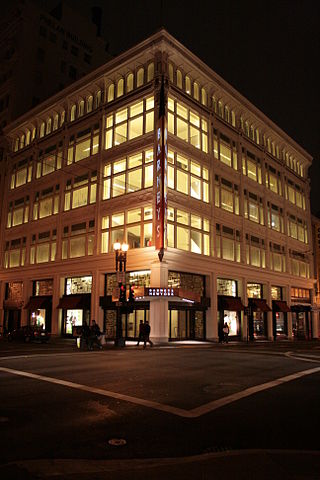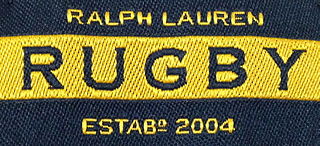
The Ivy League is an American collegiate athletic conference, comprising eight private research universities in the Northeastern United States. The term Ivy League is typically used outside sports to refer to the eight schools as a group of elite colleges with connotations of academic excellence, selectivity in admissions, and social elitism. Its members are Brown University, Columbia University, Cornell University, Dartmouth College, Harvard University, Princeton University, University of Pennsylvania ("Penn"), and Yale University. The conference headquarters are in Princeton, New Jersey.

Macy's is an American department store chain founded in 1858 by Rowland Hussey Macy. It has been a sister brand to the Bloomingdale's department store chain since being acquired by holding company Federated Department Stores in 1994, which renamed itself Macy's, Inc. in 2007. It is the largest department store company by retail sales in the United States as of 2015.

Preppy is an American subculture associated with the alumni of college-preparatory schools in the Northeastern United States. The term, which is an abbreviation of "preparatory", is used to denote a person seen as characteristic of a student or alumnus of these schools. Characteristics of preppy individuals include a particular subcultural speech, vocabulary, dress, mannerisms and etiquette reflective of an upper class and old money upbringing.

Brooks Brothers is an American high-end luxury fashion company founded in 1818, the oldest apparel brand in continuous operation in the United States. Originally a family business, Brooks Brothers produces clothing for men, women and children, as well as home furnishings. Brooks Brothers licenses its name and branding to Luxottica for eyewear, Paris-based Interparfums for fragrances, and Turkey-based Turko Textiles for its home collection.

John Wanamaker Department Store was one of the first department stores in the United States. Founded by John Wanamaker in Philadelphia, it was influential in the development of the retail industry including as the first store to use price tags. At its zenith in the early 20th century, Wanamaker's also had a store in New York City at Broadway and Ninth Street. Both employed extremely large staffs. By the end of the 20th century, there were 16 Wanamaker's outlets, but after years of change, the chain was bought by A. Alfred Taubman in late 1986, and added to his previous purchase of Woodward & Lothrop, the Washington, D.C., department store. In 1994, Woodies, as it was known, filed for bankruptcy. The assets of Woodies were purchased by the May Company Department Stores and JCPenney. In 1995, Wanamaker's transitioned to Hecht's, one of the May Company brands. In 2006, Macy's opened in the former Philadelphia Wanamaker's Department Store, now called Macy's Center City. The building is a National Historic Landmark. One if its expansions was designed by master architect Daniel Burnham. It contains the Wanamaker Organ, the largest functional organ in the world.

Gimbel Brothers was an American department store corporation that operated for over a century, from 1842 until 1987. Gimbel patriarch Adam Gimbel opened his first store in Vincennes, Indiana, in 1842. In 1887, the company moved its operations to the Gimbel Brothers Department Store in Milwaukee, Wisconsin. It became a chain when it opened a second, larger store in Philadelphia, Pennsylvania, in 1894, moving its headquarters there. At the urging of future company president Bernard Gimbel, grandson of the founder, the company expanded to New York City in 1910.

The Official Preppy Handbook (1980) is a satirical reference guide edited by Lisa Birnbach and written by Jonathan Roberts, Carol McD. Wallace, Mason Wiley, and Birnbach. It discusses an aspect of North American culture described as prepdom. In addition to insights on prep school and university life at socially acceptable schools, it illuminates many aspects of the conservative upper middle class, old money WASP society. Topics range from appropriate clothing for social events to choosing the correct college and major.

Barneys New York is an American department store chain founded in 1923 by Barney Pressman. The company operated full-line department stores in the United States from 1923 until 2020. Authentic Brands Group acquired Barneys' intellectual property in 2019, and has licensed the brand to Saks Fifth Avenue for specialty departments within its flagship stores since 2021.

Rugby Ralph Lauren was an American clothing brand launched in 2004 under the management of parent company Polo Ralph Lauren, the line has been retired. The brand specialised in Preppy/Rugby inspired lifestyle apparel for male and female clientele ages 16 through 25. Rugby also encompassed Rugby Food & Spirits, a small café modeled after the brand and offering dining inspired by the Rugby theme. Rugby merchandise was available at twelve stores throughout the United States, as well as one in Covent Garden in London, UK. By August, 2008 merchandise was also available online at Rugby.com.

Ivy League is a style of men's dress, popular during the late 1950s in the Northeastern United States, and said to have originated on college campuses, particularly those of the Ivy League. It was the predecessor to the preppy style of dress.
Paul Stuart is a men's luxury clothing brand based in New York City. The company has four boutiques in the US, and is sold at department stores nationwide in Japan. Since 2012, it has been owned by Mitsui.
Mark McNairy is an American fashion designer. He is currently the designer of mcnairy&co, a menswear brand headquartered in New York City. He is the former creative director for the Ivy League inspired clothing company J. Press, as well as his own collection simply known as Mark McNairy New Amsterdam.

Bond Clothing Stores, Bond Clothes, Bond Clothiers, or Bond Stores, was a men's clothing manufacturing company and retailer. The company catered to the middle-class consumer.

The history of Abercrombie & Fitch began in the 19th century and extends into the 21st century. Key figures who changed and influenced the course of Abercrombie & Fitch's history include co-founders David T. Abercrombie and Ezra Fitch, Limited Brands and Michael Jeffries, the former Chairman and CEO.
Joe Fresh is a Canadian fashion brand and retail chain created by designer Joe Mimran for Canadian food distributor Loblaw Companies Limited. It was formed in 2006. The label includes adult and children's wear, shoes, handbags, jewelry, beauty products, and bath items.
Tommy Hilfiger B.V., formerly known as Tommy Hilfiger Corporation and Tommy Hilfiger Inc., is an American clothing brand, manufacturing apparel, footwear, accessories, fragrances and home furnishings. The company was founded in 1985, and the brand's merchandise is sold in department stores and over 2000 free-standing retail stores in 100 countries. In 2006, private equity firm Apax Partners acquired the company for approximately $1.6 billion. In March 2010, PVH Corp. bought the company. Daniel Grieder was appointed CEO in July 2014, while founder Tommy Hilfiger remains the company's principal designer, leading the design teams and overseeing the entire creative process. Global sales in retail through the brand were US$9.1 billion in 2022.
Clifford Grodd was an American clothier who served as president and chief executive of the Paul Stuart men's and women's clothing retailer.
Joseph is a luxury fashion brand and retail chain that was established in London by Moroccan entrepreneur Joseph Ettedgui and his family in 1972.
Jeffrey Banks is an American fashion designer and author, who has been described as a major black fashion maker.

The Lord & Taylor Building is an 11-story commercial building in Midtown Manhattan, New York City, that formerly served as Lord & Taylor's flagship department store in the city. Designed by Starrett & van Vleck in the Italian Renaissance Revival style, it is at 424–434 Fifth Avenue between 38th and 39th Streets. Since 2023, it has been an office building for Amazon.














